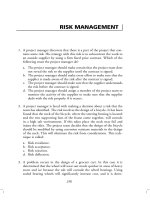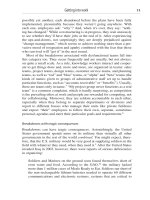Beyond Management Taking Charge at Work_1 docx
Bạn đang xem bản rút gọn của tài liệu. Xem và tải ngay bản đầy đủ của tài liệu tại đây (594.55 KB, 23 trang )
Beyond Management
Taking Charge at Work
Mark Addleson
© Mark Addleson 2011
All rights reserved. No reproduction, copy or transmission of this
publication may be made without written permission.
No portion of this publication may be reproduced, copied or transmitted
save with written permission or in accordance with the provisions of the
Copyright, Designs and Patents Act 1988, or under the terms of any licence
permitting limited copying issued by the Copyright Licensing Agency,
Saffron House, 6-10 Kirby Street, London EC1N 8TS.
Any person who does any unauthorized act in relation to this publication
may be liable to criminal prosecution and civil claims for damages.
The author has asserted his right to be identified
as the author of this work in accordance with the Copyright,
Designs and Patents Act 1988.
First published 2011 by
PALGRAVE MACMILLAN
Palgrave Macmillan in the UK is an imprint of Macmillan Publishers Limited,
registered in England, company number 785998, of Houndmills, Basingstoke,
Hampshire RG21 6XS.
Palgrave Macmillan in the US is a division of St Martin’s Press LLC,
175 Fifth Avenue, New York, NY 10010.
Palgrave Macmillan is the global academic imprint of the above companies
and has companies and representatives throughout the world.
Palgrave
® and Macmillan® are registered trademarks in the United States,
the United Kingdom, Europe and other countries.
ISBN 978–0–230–30816–9
This book is printed on paper suitable for recycling and made from fully
managed and sustained forest sources. Logging, pulping and manufacturing
processes are expected to conform to the environmental regulations of the
country of origin.
A catalogue record for this book is available from the British Library.
A catalog record for this book is available from the Library of Congress.
10987654321
20 19 18 17 16 15 14 13 12 11
Printed and bound in Great Britain by
MPG Group, Bodmin and King’s Lynn
For Rob and Kate (a.k.a. Dan and The P) –
they have always been beyond management
This page intentionally left blank
CONTENTS
List of Fi gures x
Acknowledgments xi
1 The end of the line 1
Talk about a revolution 1
The story in outline 6
The view from the top 6
The view from practice 7
2 Getting into work 8
Breakdowns large and small 8
Large-scale breakdowns 9
Smaller-scale breakdowns 10
Breakdowns with tragic consequences 11
Systematic disorganization 12
Looking the wrong way, at the wrong things 14
Going “inside” work 15
“Inside” or “outside” is a matter of involvement 16
Work from the top 18
Work in practice 20
Behind the breakdowns 22
3 Organizing: getting the beat 24
Organizing is full of life 24
The two challenges 26
A first-hand account 29
4 Jeff’s journal: project work on the inside 31
Part 1: questions that keep coming up 31
What’s your problem, Jeffrey? 31
A management malfunction 32
The “client” view of project work 34
v
vi
Contents
Where is the customer? 35
Where to from here? 37
Part 2: how things actually work 38
Jeff’s cloud theory 38
The connections matter 40
Part 3: structure in organizing 42
Organizing = effort + magic 42
Work emerges 43
Self-organizing 43
Networks of conversations 44
Relationships 46
Spaces for conversations 47
5 Left-brain management and right-brain organizing 51
Parallel universes at work 51
Left-brain management and right-brain organizing 54
Tools and talk 56
Organizing practices: talk and tools 58
Taking on the work of organizing 60
6 Knowledge-work in close-up 62
What is knowledge-work? 62
A definition 63
Picturing knowledge-work 65
Network maps are traps 67
Networks are never complete 69
Knowledge-work is social and in “the spaces in-between” 70
Where is knowledge-work? 71
Social spaces 73
Sacred places 74
The qualities of social spaces 75
7 The work of organizing with giant hairballs and
wicked problems 77
What is the work of organizing? 77
The case study 78
The work of negotiating meaning 80
The work of creating the work 81
Hairballs and orbiting 83
The work of building networks and negotiating boundaries 86
Boundaries as bridges a nd barriers 87
Fragmentation c ontributes to boundaries 88
Contents
vii
Multitasking makes connections tricky 89
Putitdowntowickedproblems 90
These are collective problems 92
The work of aligning (the “bottom line” of organizing) 94
What aligning is and isn’t 94
8 Tools are the empty heart of management or why
strategic i nitiatives fail 98
Management myopia 98
Work practices that are missing in action 100
The genie that turned ugly 103
BPR at Jet Propulsion Labs 104
BPR through a management lens 105
What is a process? 106
Lay down those tools 107
A Department of Homeland Security 107
Redesigning processes or structures isn’t the real work 109
The work of reorganizing 110
9 Practices that break the mold with agility and care 113
Agile methods and knowledge work 113
Problems with the waterfall method 115
“Scrum”: an agile method 118
Caring about work 120
Nursing practice: the work of caring 122
Bringing back care 123
10 In search of low-control organizing practices:
community, care, cooperation, and commitment 125
The catch-22 of new practices 125
Alternatives to control and compliance 126
Communities of practice 128
What is the secret? 131
Caring relationships make the difference 132
The spirit of ubuntu 133
Crossing boundaries 134
11 Taking on the work of organizing 136
Closing the divide between work and organizing 136
Where to begin 137
Like being on a trapeze 138
Letting go while catching on 139
viii
Contents
Relationships and accountability 140
Talking the talk 142
Cultivating a new narrative is tough 144
New language for new conversations 146
Walking a tightrope 146
What is your story? 148
Three words that must go: management, organization,
leadership 149
12 Conversations for aligning: openness, commitments,
and accountability 152
Aligning 152
Three domains of conversations 153
Illustrating the framework 155
What to do with the framework 156
Missing conversations 157
Conversations for openness 159
Conversations for commitments 161
Conversations for accountability 162
Accountability as a way of being 164
There is a place for rules 166
Conversations for accountability serve a dual purpose 167
Keeping talk and tools separate 168
13 Organizing moves 170
We are still short of an answer to “how” 170
Organizing moves from a bove 171
Letting go 172
Transforming relationships 173
Promoting accountability 173
Organizing moves from below: extricating yourself
and your work 174
Moving up 175
Facilitating open discussion 176
Negotiating accountability 177
14 Handling hierarchy and more 179
Change that pushes all the buttons 179
Handling hierarchy 180
“Orbiting” is not a solution 181
Reframing the problem of hierarchy 182
Contents
ix
The object is aligning 182
Conversations for openness, accountability, and
commitment 184
From the dance floor and balcony 185
Negotiating an end to apartheid 186
Slow and steady or bold and brave 187
Change “on management’s terms” is not practical 187
Under the radar 188
The IT cavalry to the rescue? 190
Most IT departments don’t understand collaboration 191
Putting t ools in the hands of users 191
The importance of being present 192
Casting a round for partners 193
Keeping an eye on your purpose 194
Encourage active participation 196
15 Good work wanted 198
Who knows good work? 198
Work is human to the core 200
In the eyes of the beholders 203
A god’s-eye perspective and a human one 204
Everything exceeds our grasp 207
Hiding from the humanness of work 209
Management has colonized life 211
Going topless 212
Notes 216
References 257
Index 267
LIST OF FIGURES
1.1 Two perspectives on work 7
4.1 Management 33
4.2 Teams’ and management’s views 36
4.3 Clouds make a project 39
4.4 Connections make a project 41
4.5 Conversations make a project 45
4.6 Picturing a social space 50
5.1 Parallel universes of management and organizing 55
5.2 What we see and don’t see 57
6.1 Two pictures of factory-work, ca. 1930 66
6.2 Diagram of an organizational network 68
6.3 The standard view of what happens in networks 70
6.4 Some knowledge workers at work 72
7.1 Comparing organizing with technical work 93
8.1 Work practices 101
9.1 The waterfall model 115
11.1 Letting go! 139
11.2 A delicate balance 147
12.1 Three domains of conversation: a framework for
organizing 155
15.1 A pyramid-maze puzzle 206
x
ACKNOWLEDGMENTS
Many people—friends, colleagues, and others—have had a hand in shap-
ing this book. Dana Dolan generously read the final version and offered
careful, detailed comments. She also asked me to remind readers who have
the stamina to tackle the chapter notes that there is another book there
(I have the impression she thinks it is the more interesting one!). Jessica
Heineman-Pieper, Tony Joyce, Art Kleiner, Mark Leheney, Eric Meyer,
Neil Olonoff, and Bill Tulloh all went beyond the call of duty and/or
friendship in reading and commenting on typescripts.
Working with Jennifer Berger was a spur to start putting fingers to
keyboard. Jeff Conklin introduced me to wicked problems many years
ago and things have gone downhill ever since. My consulting colleagues,
Scott Brumburgh, Christiane Frishmuth, and Mikaela Seligman, have tried
very hard to keep me focused—against my natural impulses—on practical
matters; as has Raj Chawla, to whom I owe a special thank you for his
encouragement as well as his friendship. From the Hermanus crew, who
adopted us during Cape winters, I want to thank Beth and Noel Hunt, of
Hemingway’s Bookshop, for their company and encouragement.
On the publishing side, John Wright, literary agent, very generously
guided me through the process of creating a prospectus, then Stephen
Rutt at Palgrave Macmillan was kind—or, I’d like to think, wise—enough
to take the manuscript. I am grateful to all who have helped turn words
and a few images into a handsome volume, in particular, Eleanor Davey-
Corrigan at Palgrave Macmillan, and Keith Povey with Nick Fox, who, as
editors, enabled me to handle the hurdles of the important final phases.
Ioana Belcea did the marvelous drawings for Chapter 11. How fortunate
I am to have a gifted iconographer as a neighbor.
I’m especially privileged to work with bright, experienced graduate
students, my real teachers. Their enthusiasm and willingness to run with
half-baked ideas brought this book to life.
Lastly, but certainly not leastly, I am deeply grateful to Jen, compan-
ion and advisor on this and many other journeys. Beyond Management
would not have seen the light of day without her wisdom, humor, patience,
and care.
M
ARK ADDLESON
xi
xii
Acknowledgments
The author and publishers are grateful to the following for permission to
reproduce copyright material as indicated:
Figure 6.1 “Two pictures of factory-work, ca. 1930” (p. 66)
Source: “Behind the Scenes in the Machine Age,” 1931, a film produced
by the Women’s Bureau of the United States Department of Labor.
Figure 6.2 “Diagram of an organizational network” (p. 68)
Source:Valdis Krebs (www.orgnet.com/decisions.html). Reproduced with
permission.
Figure 8.1 “Work practices” (p. 101)
Source: Adapted from Etienne Wenger, Communities of Practice: Learn-
ing, Meaning and Identity, p. 63. Used by permission of Cambridge
University Press. Copyright
c
1998 by Etienne Wenger.
“Manifesto for Agile Development” box (p. 113)
Source: The Agile Alliance (agilemanifesto.org). Reproduced with
permission.
Figure 9.1 “The waterfall model” (p. 115)
Source: Adapted from a diagram by Paul Hoadley. Used with his
permission.
Figure 11.1 “Letting go!” (p. 139)
Drawn by Ioana Belcea. Used with her permission.
Figure 11.2 “A delicate balance” (p. 147)
Drawn by Ioana Belcea. Used with her permission.
Figure 15.1 “A pyramid-maze puzzle” (p. 206)
Source: Based on a puzzle marketed by Loncraine Broxton. Used with
permission of the Lagoon Trading Co. Ltd.
CHAPTER 1
The end of the line
Talk about a revolution
Management is dead, but don’t take my word for it. Peter Drucker saw
this first. He begins The Practice of Management, the book that made
him famous, with a bold prediction: “management will remain a basic
and dominant institution perhaps as long as Western civilization itself
survives”.
1
What a surprise, then, to find him administering the last
rites to management a little more than 40 years later: “as we advance
deeper into the knowledge economy, the basic assumptions underlying
much of what is taught and practiced in the name of management are
hopelessly out of date As a result, we are preaching, teaching, and
practicing policies that are increasingly at odds with reality and therefore
counterproductive.”
2
For most of his long and illustrious career, Drucker, who had a large
following, wrote about how to be a good manager, maintaining that man-
agement is fundamental to a prosperous and progressive society. Toward
the end of his career, “the father of modern management” turns his back
on the profession he helped to establish, warning that management has
run its course. He now says that management practices are counterpro-
ductive, meaning they do the opposite of what you want. Intended to make
organizations more efficient and more profitable, this is an admission that
they are actually disorganizing. What should we make of this dramatic
reversal?
Prolific writer that he was, it is relatively easy to keep track of Drucker’s
intellectual journey and see why he made this U-turn. You might say it was
simply a matter of putting two and two together, although doing the math
needed someone not only well versed in management but also attuned to
what was happening in the world of work.
3
By the 1960s, noticing indus-
trial work was on the wane, he coined the expressions “knowledge work”
and “knowledge worker” to describe professionals in the nascent infor-
mation t echnology (IT) industry. What Drucker saw, and what knowledge
workers know instinctively, is that management is all right for organizing
factories. Factories run with the regular rhythm of machines, but old-style
1
2
Beyond Management
factory-work had been solitary, repetitive, mindless, with workers little
more than automatons. Knowledge-work is an entirely different story.
Manufacturing jobs have all but disappeared, “off-shored” to countries
where labor is cheap, productive, and, for lack of regulations, exploitable.
The rest of us—administrators, bankers, consultants, designers, entertain-
ers, IT specialists, journalists, lobbyists, musicians, nurses, restaurateurs,
secretaries, social workers, trainers, and writers—are knowledge workers,
as are janitors, landscape crews, and plumbers. Knowledge workers orga-
nize themselves. With a common interest in what they are doing, they
cooperate, share knowledge, learn from one another, assign tasks, and
make decisions while they work. Using management tools and techniques
to organize knowledge-work makes a mess of work, which we’ve been
doing for half a century or more.
As pretty much everyone is a knowledge worker nowadays, we’d bet-
ter do something about this. The question is what. Drucker only hints at
knowledge-work being a game-changer. He doesn’t explain why or tell us
how to deal with the fact that management practices are ubiquitous and
deeply entrenched. What is wrong with “old” management? What does
“new” management look like in the age of knowledge-work? And how do
we remove the old and replace it with the new? Here are three large gaps
that need filling, and I plan to fill them. To offer a way forward I’ll pose
four questions, answering a what, a why, a couple of wheres, and a how.
What is knowledge-work? Why don’t management and knowledge-work
mix? And, once we know where management is deficient and where to
look for new practices, how do we replace the old with the new? So, if you
follow my story, you’ll understand and be able to respond to the growing
disillusionment with management.
Having lived in the shadow of management for generations, almost
everyone still seems to take it for granted that when it is a question of
getting the best results from work you turn to management for answers.
4
True, there is some disagreement about exactly how to get the best results;
for example, whether the usual measures of managers’ performance, to
which their compensation is often tied, contribute to an unhealthy empha-
sis on s hort-term outcomes.
5
But, leaving aside serious criticism from the
Left, disagreements about the substance of management, over how to man-
age organizations, are generally mild. The most common complaint is that
something or other is missing; that there isn’t enough emphasis given to,
say, processes as opposed to structures.
6
Such complaints invariably come
with the assurance that the problem can be fixed, with the promise that,
when fixed, management will once again be in good shape, and with the
claim by the critic that he has just the tool to put things right.
The end of the line
3
Lately, we’ve been hearing a different kind of objection from main-
stream writers much like Drucker, who are dissatisfied with management
and doubtful about its future. Gary Hamel is one; convinced that man-
agement has passed its sell-by date yet evidently not ready to toss it all
away (he makes a handsome living as a management consultant, so this
is probably not surprising). Writing in the Harvard Business Review,an
establishment stronghold, he maintains that “management, like the com-
bustion engine, is a mature technology that must now be reinvented for a
new age.” What is needed is a “management revolution no less momen-
tous than the one that spawned modern industry.”
7
This probably sounds
like the kind of hyperbole we’ve come to expect from management gurus,
but Hamel is dead right and, I’m sure, realizes that redoing manage-
ment from scratch involves a far-reaching agenda that calls for profoundly
political action.
How seriously should we take Hamel and other agnostics? Having held
an orthodox line, we can be certain that their past disagreements with
management have been relatively mild, probably over practices, and that
they’ve come to their new positions only after some soul searching. Agnos-
ticism covers principles as well as practices and, if their status in the
profession isn’t a good enough reason to pay attention to what they’re
saying, there is another compelling one. They speak for a very large group
who are fed up with standard management methods. Actually, there are
two groups.
One is the workers caught up in “change management” initiatives, con-
fused and disheartened by a maelstrom of internal organizational changes
that they’re unable to make head or tail of. In the course of a restructuring,
reorganization (a “reorg”), downsizing, or merger, divisions are renamed,
sales teams which were organized by product are reorganized by region,
new mission statements and organizational (org) charts appear magically
on the walls and the web, and they have new job descriptions. What is the
point of it all? When the smoke finally clears little has changed. With the
old systems and procedures still in place, everyone continues to work as
they did before, with one important difference: some of their colleagues
have been fired and those who still have jobs feel insecure and anxious
about theirs. Is this an improvement and, if so, why and for whom?
Then, there are managers at all levels, in all kinds of organizations, who,
when they talk frankly about their work, will tell you they, too, are frus-
trated. Often referring to their subordinates’ lack of commitment and/or
accountability, they’ll say they aren’t getting the results they want. They
blame poor teamwork for slippage that includes missed deadlines and
projects that are over budget and may tell you that the tools and techniques
4
Beyond Management
they’ve learned to rely on, from performance measures to IT systems,
don’t work as they’re supposed to. I’ve heard a few managers say that
they’ve run out of ideas about what to do and I’m certain there are many,
many more who feel the same way.
If you are in either group, dissatisfied with what you see and wanting to
do something about it, you are a potential activist for change and this book
is meant for you. The same goes for management consultants and organi-
zation development practitioners who advise organizations about change.
I’ve written the book to explain what is going on and what you can do
about it. And, even if you’re not in one of these groups, there is every
reason for you to take an interest, make a stand, and become an activist.
Whether it is the work of medical professionals, county maintenance
workers, volunteer community organizers, soldiers, financial brokers, or
structural engineers, how we manage (i.e. organize) the work we do affects
all sorts of people in different ways, so we need to see to it that we do it
properly.
Whenever people want to accomplish anything they need to orga-
nize, whether they are arranging a wedding reception, publishing a book,
drilling an oil well, or even if it is just two of them trying to schedule
lunch. At work, ordinary human acts of organizing are surrounded by
dense, almost impenetrable layers of procedures and jargon held together
by pseudo-science. What we call “management” is a morass of rules, reg-
ulations, and rigid structures that spring from a command-and-control
mentality, coupled with an obsession for measuring and an insatiable
appetite for data. This is because, as a so-called “science,” management
is meant to be empirical and objective, which means that when it comes to
making decisions, “hard data” or “facts” are supposed to trump whatever
it is that decision-makers think, feel, believe, and value. These trappings
of science and weasel-words like “efficiency” (translation: “nothing mat-
ters except the bottom line”) are like a protective covering that makes it
difficult to see that management is actually about people organizing to get
things done with other people.
There are many who’ll argue that doing things the management way—
the MBA way, with all those rules, structures, systems, and data—is the
right way and possibly the only way to organize work. And you may
think you have every reason to believe them. They seem to speak on
good authority. After all, they have hundreds, if not thousands, of busi-
ness books, and untold numbers of consultants, not to say all the programs
at management schools, to back up their story.
8
But, unwrapping manage-
ment practices, I want to peel away the protective layers, so you can see
work, especially knowledge-work, in a way that management books don’t
The end of the line
5
tell you about and see how people actually do it. You’ll also see why,
underneath the pseudo-science and impressive language of “scorecards,”
“value propositions,” “human capital,” and “data mining,” management is
a cause of widespread dissatisfaction at work as well as a source of orga-
nizational breakdowns. You’ll go further too. If you’re an activist, or want
to become one, you will find out what you can and should do about this
unacceptable state of affairs.
The problem we’re up against, which Drucker saw, is that management
cannot be transplanted from the industrial age, where it began, into the age
of knowledge-work, from steam power and smokestacks to smoke-free
offices. Today’s good management, whether taught in business schools
or learned on the job, consists of practices devised in a world dominated
by machines for running factories with production lines. But, the work
most people do today, like renewing run-down urban communities, selling
office equipment, designing software, educating children or adults, orga-
nizing labor unions, and providing financial aid to support international
development work, isn’t at all like factory-work. Knowledge-work marks
the end of the production line, which means, too, it is the end of the line
for management.
9
Once you understand that management practices are playing havoc with
knowledge-work and understand why, it is relatively easy to see what you
ought to do. Even when you want to, though, it is quite another thing
to accomplish the change. Bureaucracy, hierarchy, aggressive competi-
tion, and bottom-line accounting, some of the ideas and practices that are
bad for knowledge-work, are so much part of the scene that is difficult
to conceive of workplaces without them. Replacing management means
tinkering with the vitals of society and challenging an ideology that has
become a matter of faith. This takes a strong stomach. If it was easy to
do, we would have eliminated the worst practices by now. It is going to
take a change of heart, seeing work through new eyes, with new values,
to replace management; but I won’t have done my job unless you know
why it’s worth the effort and I can point you to the kinds of collabo-
rative workplaces that are right for knowledge-work, where people are
committed to doing good work and are accountable to one another for
doing it.
We may be a long way from where we ought to be, but, on the upside,
we don’t have to look far, or hard, to find practices that support knowledge-
work. The right ones could not be closer. Scientific advisors drafting a
policy document on climate change, a mother taking her kids to after-
school activities, or teens going to movies with their friends organize; so
do you and I. Organizing is an important part of life. We all know about
6
Beyond Management
it and know how to do it. Organizing is collective work, which is why
knowledge workers participate in networks, establish groups, and form
teams. And, whether they do it face-to-face, on the phone, or, nowadays,
online, on social networking sites or texting, organizing is, unquestionably,
a grass-roots effort. At work, what we are after, in fact, are ordinary, every-
day ways of organizing that have served human beings well, all over the
world, for thousands of years before management appeared on the scene
roughly a century ago. Let me tell you, briefly, how I plan to help you find
and—if you’re an activist—get into your “new” work practices.
The story in outline
Oscar Wilde is supposed to have said that there are two kinds of people:
those who divide the world into two kinds of types of people and those
who don’t.
10
In writing about work, management, and organizing I find it
helpful to make distinctions, which surely means I’m the dividing kind.
For now I’ll talk about some of the distinctions that are central to my
story, leaving others for later. The story begins with two ways of getting
work done. One is “management,” which is familiar. The other I’ll call
“organizing.” I’ll also describe and contrast two kinds of work: “factory-
work,” which is physical, repetitive, solitary, and often quite mindless; and
“knowledge-work,” which on every count is just the opposite. Invented for
organizing factory-work, we now use management to organize knowledge-
work—and the results are entirely unsatisfactory.
The view from the top
The word “management” covers the things managers do, like making
plans and giving directions to subordinates. It also refers to the managers
themselves—the people with titles such as “vice president,” “director of
operations,” or “district supervisor.”
11
Perhaps it is less obvious that there
is a third way of thinking about “management”: as point of view or per-
spective. Here, management is a particular way of looking at organizations
and the human activities we call “work.” I probably don’t have to explain
why I think of it as the “view from the top.”
12
In the view from the
top there are organizations: things that have to be run efficiently. It is
management’s job to do this by “directing resources.” These include “cap-
ital” (machines and other replaceable assets) and “workers” (or nowadays
“human capital”). “Managing work” means one or more people at the
The end of the line
7
very top of the organization, who are not actually doing the work, are in
charge, delegating authority through a “chain of command,” telling people
what to do, when, and how, or, quoting a standard definition of manage-
ment, “planning, coordinating, and controlling” everything and everyone
below them.
The view from practice
Writing about how the view from the top influences the way we see and
organize work, I’ll contrast it with the “view from practice.” This is the
view you have when you are actually doing your work, in the trenches
so to speak, intimately involved with colleagues or clients and aware of
what they are doing, saying, and even what they are thinking and feeling,
as you make plans together and talk to one another about what you want
to accomplish. Figure 1.1 is a summary of these distinctions, the main
ones I use t o tell my story. Management, the view from the top, histori-
cally is tied to factory-work. It takes a view from practice to understand
knowledge-work and to see how knowledge workers organize their work.
View from practice
Organizing
Knowledge-work
View from the top
Management
Factory-work
Figure 1.1 Two perspectives on work
Around organizations only the management view (the left-hand side
of Figure 1.1) carries real weight. The result is we miss what is most
important about knowledge-work: the organizing knowledge workers do
as they work. With their view from the top, managers are preoccupied
with documentation, data, directives, deliverables, deadlines, and dol-
lars. These—what I’ll call the “six Ds” for short—have very little to do
with work and don’t get anything done. If knowledge workers weren’t,
themselves, constantly organizing, nothing could or would get done. But
you don’t see this from the top. You need the view from practice. Once
you have it, it’s quickly apparent that management is incompatible with
knowledge-work. So it is time to shine a spotlight on knowledge workers:
to see what the work of organizing is all about, how they do it, and why
management practices hinder rather than help them.
CHAPTER 2
Getting into work
Breakdowns large and small
Business books have a similar, simple agenda. They tell you how to
manage people and organizations successfully. When it comes to how
to run the whole operation, they have a similar, simple recipe. They
start with the premise (often left unsaid) that organizations consist of
two separate sets of activities—management and work—and then concen-
trate on management alone. Work and workers hardly feature. Managers
(“above”) plan, budget, schedule, and coordinate activities; and workers
(“below”) follow those plans and schedules. Managers need data and tools
to solve problems. This data comes up, from below, in reports, databases,
and the like. Workers need “incentives”—both “carrots” and “sticks”—to
persuade them to work hard. These come down from above.
As there are enough business books to fill a decent-sized public library,
you’d think, by now, we would be quite good at doing what they say can
be done if you take their advice. Organizations, running like clockwork,
producing excellent bottom-line results, would be providing first-rate ser-
vices and top quality products to highly satisfied customers. In each you’d
find a homogeneous work culture and contented employees committed
to a shared vision and common mission. In short, in the hands of capa-
ble managers and inspirational leaders, everyone and everything would be
performing at its peak. Does this sound like your organization? I’m con-
fident in saying that it is not like any I know in the business, government,
or nonprofit worlds, because, apart from that fact that it doesn’t make
sense to separate doing the work from organizing or managing it (it isn’t
practical), the cast of one-dimensional characters—managers, executives,
supervisors, leaders, administrators, workers, and so on—in the idealized
and romanticized abstractions these books call “organizations” lacks all
traces of humanity. This begs two questions. What planet are the writers
from? And what, exactly, are they trying to tell us?
Ironically, the parodies of organizations, their managers, leaders, and
work, in Scott Adam’s Dilbert cartoon strip or the TV comedy The Office
8
Getting into work
9
seem infinitely more real than the paragons of rationality you find in
business books or articles. Take the people. Some are imaginative and
others dull; some visionary, others short-sighted; some kind, others cruel;
some cooperative and helpful, others competitive and perverse; some seem
to have an insatiable desire for more power, recognition, or money (pos-
sibly all three), while others, in spite of their grumbling, are more or
less content with their lot. As satire often depends on highlighting one
character’s distress (e.g. Dilbert’s) at another’s attitudes or actions (his
pointy-haired boss), or on exposing awkward and sometimes disastrous
relationships, there’s no mistaking that work life is social and, as such, is
complicated.
1
It is also impossible to overlook the fact that organizations
are punctuated by breakdowns, both big and small, or that these two sets of
factors—the social complexity of work and the breakdowns—are related.
2
Though management books seldom mention breakdowns, in real life
they range from the largely inconsequential—disagreement over what
color Post-it notes to use for urgent as opposed to normal tasks—to deba-
cles on a scale that are sometimes quite breathtaking, especially when you
consider the amount of money spent and how little, if anything, there is to
show for it. To highlight some of these breakdowns, large and small, I’ve
chosen examples which illustrate that they are not confined to one type of
organization, but are as prevalent in government agencies, say, as they are
in businesses or nonprofits.
Large-scale breakdowns
It is easy to find examples of large-scale breakdowns, as some make it
into the media. Many, such as failed mergers, often don’t become pub-
lic and remain dirty secrets of management. Software projects, costing
hundreds or even thousands of millions of dollars are abandoned when,
eventually, it becomes clear they aren’t going to meet a client’s require-
ments and the provider’s promises.
3
Bank collapses in the last few years
have once again brought to light the irresponsible and careless strategies
and self-serving actions of executives of institutions whose reputations
and business depend on prudence, responsibility, and trust. The question
of how to prevent future attacks like those in 2001 on the World Trade
Center and the Pentagon led to the United States Congress authorizing the
creation of a Department of Homeland Security. Surely it doesn’t need
a formal inquiry to agree that consigning more than 30 huge, bureau-
cratic, often competing departments and agencies, with their own internal
schisms and rivalries, to one enormous bureaucratic structure adds up to
10
Beyond Management
a fiasco: one which won’t make employees any more willing, or able, to
share information.
In the same vein, consider projects which, when completed, are next
to useless. These aren’t exactly the Ford Edsels of their time, because the
Edsel ran. It just wasn’t appealing enough to sell in numbers that would
have made it profitable.
4
I’m thinking of programs and projects which
don’t work out at all, like large-scale management interventions, including
mergers, that don’t have discernible benefits; or development-aid pro-
grams that don’t deliver anything resembling development or poverty
relief.
5
Time and again, development agencies, employing highly quali-
fied people at generous salaries, compile data and formulate policies using
sophisticated equipment and complex models. Then they spend vast sums
of money, but in ways that do hardly any good for the poor and destitute in
the countries they are “assisting.” When these projects reach their comple-
tion dates, or exhaust their budgets, they are over, no matter what they’ve
accomplished. The expatriots staffing them, who are getting ready to move
on to the next assignment on their schedule, pull out, often leaving a vac-
uum, but without so much as either a thought for what they’ve left behind
or a care about what will follow.
6
What major accomplishments can you
point to after more than half a century—not to say the billions of dollars
spent— of “managing development”?
Smaller-scale breakdowns
I’m especially interested in the countless, smaller-scale breakdowns that
happen every day at work that are hard to find unless you are on
hand—inside organizations, involved in the work—to see them. These
breakdowns often pit management against workers, so it isn’t unusual for
each to blame the other: the “higher-ups” or “the people in charge” are
blamed for bad planning and unrealistic budgets; “the workers” or “the
team” are blamed for poor performance or a lack of commitment; and they
blame one another for “poor communication.” “Couldn’t they see what
would happen?” “Don’t they know what is going on?” “Didn’t they know
what they were supposed to do?”
I’d put strategic interventions like business process reengineering into
this category. They hardly ever have identifiable, longer-term benefits, but
are usually incredibly disruptive and can ruin the lives of people who are
swept away on the premise of “improved performance.” Then there are
equally pointless “restructurings.” For some reason one misguided restruc-
turing is rarely enough. It is nearly always followed by another, and









